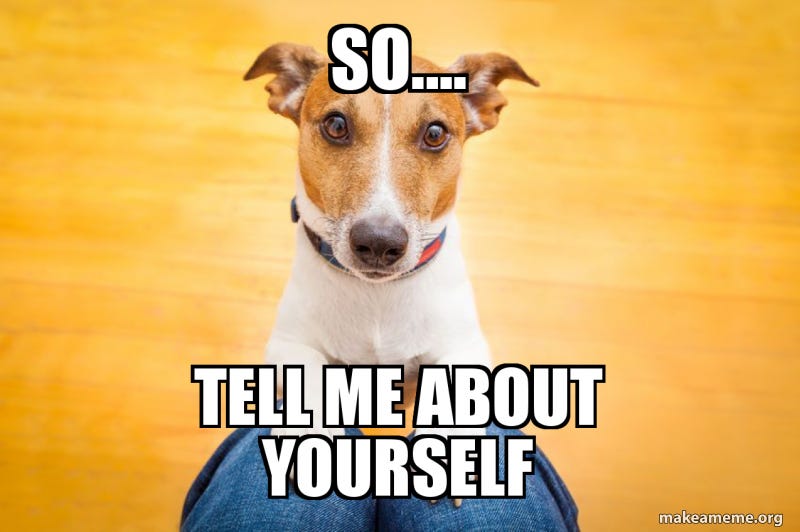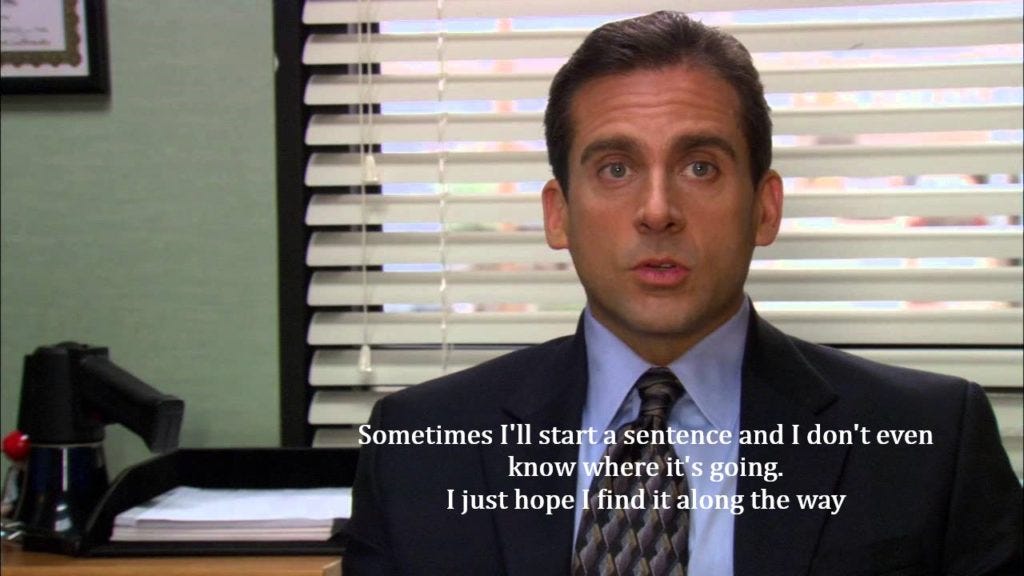How to Answer "Tell Me About Yourself" (Formula + Examples)
Crafting Your Story for Networking & Job Interviews
Whether you’re networking with industry contacts or interviewing for a job, almost every conversation will start with someone asking you:

On the surface, this seems like a harmless, easy ask. After all, it’s just a casual icebreaker before the “real” questions begin, right?
Not quite.
Many candidates don’t realize that this open-ended question is actually asking for something very specific — and that their answer can make or break their chances of landing the job.
Without a framework to guide their response, they bore the interviewer with their life story, regurgitate their resume, share inappropriate personal details, or fail to show that they’ve done their homework on the company, role, or person they’re talking to.

This is the highest-ROI question you’ll ever prepare for, and it’s practically guaranteed to come up in every interview. A strong answer not only makes a great first impression, but also sets the tone for the rest of the interview, allowing you to start the conversation on your terms.
In this article, we’ll explore the reasons why people ask this question, how to prepare your response, and share a formula for crafting your pitch (with examples) that you can customize based on your audience.
The Question Behind the Question
When a recruiter or hiring manager asks you to “tell me about yourself,” “walk me through your resume,” or “tell me a little bit about your background,” what they’re really asking is:
“Who are you and why should I hire you?”
By the time you sit down to interview, he or she has probably already read your resume, cover letter, and LinkedIn profile. They’ve seen who you are on paper. Now they want to see what you’re like in person:
Are you a clear, concise and confident communicator? How do you present yourself professionally (especially in front of colleagues, clients, and customers)?
Do you have the qualifications (skills, knowledge, and experiences) that they’re looking for in an ideal candidate?
Are you motivated to succeed and enthusiastic about this particular company and role?
Are you likeable (would you be pleasant to work with)?
Your job is to tell a story that answers these questions in 2 minutes or less. You won’t get a second chance to make a first impression, so make every word count!
Preparing Your Response
Analyze the job description.
Identify the skills, knowledge, and experiences that they are looking for in an ideal candidate (e.g. “analytical and quantitative problem-solving skills”, “leadership”, “business acumen”, “team player”, “entrepreneurial mindset”, etc.)
Make note of where you meet or exceed the requirements; these are your strengths that you’ll want to get across during the interview.
Research the company.
Read up on the company’s mission, business units, product portfolio, key customer segments and business model. Get to know their strategy and stay up-to-date on industry trends, competition and recent news. In addition to the “About Us” page, you can find this information in:
Annual Reports / 10-K filings
Investor presentations
Press releases or blog posts
CEO interviews
News outlets (Wall Street Journal, TechCrunch, etc.)
Equity research reports (SeekingAlpha, etc.)
Earnings call transcripts
Make note of where you demonstrate subject-matter expertise that is relevant to the company’s goals and the role you’re applying for. After all, the best way to convince someone you can do the job is to show them you’ve done it before (and excelled at it).
Map your profile to the company’s needs.
Identify 2-3 key achievements from your past that prove you have the strengths and expertise you identified above. Keep it relevant to the role you’re applying for and prioritize unique and memorable stories that you can claim confidently as your own.
Write out each achievement in 1-2 sentences that clearly explain the situation, your actions, and the results (with metrics, if possible). For examples on how to quantify your impact with metrics, check out my previous article, “How to Write a Rockstar Resume.”
Crafting Your Story (The Formula)
Humans are naturally drawn to stories, and your pitch should be structured as a story as well. At a high level, it should consist of 3 parts:

1. Present
Who are you? Clearly state your current role and level of experience. Don’t dilute your opening with vague, subjective phrases (“I’m a results-driven person with a strong bias towards action”). Keep it crisp and let your achievements speak for themselves in the following section.
2. Past
What was the “spark” that got you interested in this industry or role? Take the listener through your achievements in chronological order, demonstrating growing interest over time and connecting the dots with transitions to form a cohesive story. Don’t get overly detailed — you’re giving the listener an appetizer, not an all-you-can-eat buffet. You’ll have time to dive deeper later if they ask follow-up questions.
3. Future
Why are you here today? End on a strong note by summarizing why you want to work for the company and why you’re the best candidate for the role. Make this section as much about them as it is about you.
Note: Because every company and job you apply to will be different, you’ll need to customize your story based on your audience and where you’re at in your career. For example, the framework above works well for college students and recent grads, but may not work as well for professionals who already have a significant amount of work experience. Use your judgment and stick to the following principle: “What about me matters to my listener the most?”
Examples
Below are two examples of real stories I’ve used in the past. Your story will certainly be different, but I’m sharing mine in case they are helpful as a starting point.
Example #1 (2014): interviewing for Investment Banking Summer Analyst positions as a college student — accepted offer from Morgan Stanley
I'm currently a sophomore at Harvard, where I’m studying Economics and Computer Science.
My first taste of finance was in high school, when I was a YouTube musician. As a classical pianist who also loves pop music, I launched a YouTube channel featuring piano covers of Top40 songs, growing to 100,000 subscribers in 3 years. I was the sole “entrepreneur” managing my brand and spent my own money on studio equipment, licenses, and marketing. To stay organized, I made spreadsheets to keep track of my revenues and costs, and gained a basic understanding of P&L statements while running my own business.
Last summer I worked as a Software Engineering intern at Betterment, a leading robo-advisor and fintech startup. One of my projects was to build a Python automation that pulls stock price data from Yahoo Finance to update the company website, where I showed that Betterment’s portfolios consistently outperformed major indices. Learning about finance was exciting to me, but I wanted to dive deeper and learn how these securities were actually priced.
As a result, I got involved in Smart Woman Securities, a non-profit whose mission is to educate college women on finance and investing. Currently, I’m the Chief Investment Officer — I lead a team of 14 Investment Board Analysts to evaluate potential investments and manage a $40,000 equity portfolio. One of my proudest achievements was pitching a winning recommendation to sell our position in Peabody Energy Corporation, successfully divesting our portfolio from fossil fuels.
I’m here today because I want to pursue a career advising Fortune 500 clients in the tech industry on M&A and IPO opportunities. Morgan Stanley has a great track record in this space, having recently advised WhatsApp on its $16Bn sale to Facebook and led several high-profile IPOs. Given my quantitative background, experience in investing and long-term career goals, I believe I’d be a great fit for the Investment Banking Summer Analyst program.
Example #2 (2017): post-grad industry pivot from finance (Investment Banking Analyst at Morgan Stanley) to tech (Global Business Analyst at Uber) — accepted offer from Uber
I'm currently an Investment Banking Analyst at Morgan Stanley, where I’ve been for the past year since graduating from Harvard.
I’ve been passionate about the intersection of business and technology for as long as I can remember. I studied Economics and Computer Science in college and spent my first summer working as a Software Engineering intern at Betterment, a fintech startup in NYC. One of my proudest accomplishments was building a dashboard that tracks user growth and engagement metrics for the CEO. That experience led me to fall in love with data and its ability to drive strategic decisions for companies of all sizes.
I spent the following two summers and first year after graduation working at Morgan Stanley, where I am now. As an investment banking analyst in the Natural Resources Group, I help advise Fortune 500 clients in the chemical, metal, fertilizer and packaging industries on capital markets and M&A opportunities. My favorite deal was advising Loews Corporation on its $1.2Bn leveraged buyout of Consolidated Container Company as the sole analyst on a 3-person deal team. Through this and 3 other live deals I’ve worked on, I’ve sharpened my financial modeling skills and ability to analyze companies from a variety of industries.
Although I’ve enjoyed my time working in natural resources, I’m excited to transition back into tech and work at Uber, a pre-IPO “rocket ship” that is building a more sustainable future. Uber’s mission to make transportation “as reliable as running water” resonates deeply with me because I believe ridesharing is better for the environment, the economy and society. With my unique quantitative background (software engineering + investment banking), experience in data analytics (including SQL), and passion for sustainability, I believe I can bring a lot to the company as a Global Business Analyst.
Practice, Practice, Practice!
No matter how many times you read through your bullet points or notes, it’ll never sound as good out loud as it does in your head (at least on the first try).
Practice your pitch by rehearsing in front of the mirror or recording yourself until you feel confident enough to tell your story by heart (and stay consistently under 2 minutes). Remember that much of communication is non-verbal — so sit up straight, make eye contact, and smile :) A little confidence and positive energy go a long way!
——-——-——-——-——-——-——-——-——-——-——-——-——-——-——-——-
Did this article help you craft or refine your “Elevator Pitch”? If so, I’d love to hear it! Please share this article with a friend, leave a comment below, or message me directly on LinkedIn.
Until next time,
Kristina



Bonus requests:
1. How to deliver a presentation (and (not) make a slide deck) at a hackathon post-production
2. How to explain a problem, and a known solution, well enough for a 14 year old